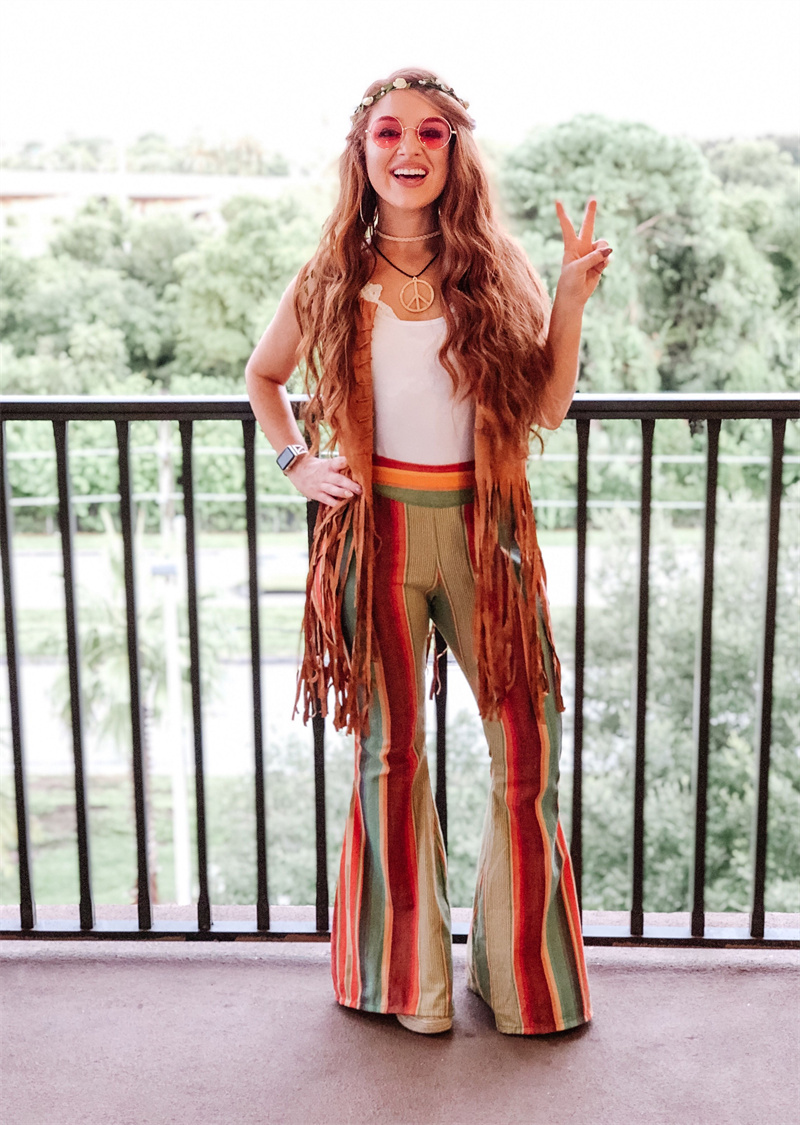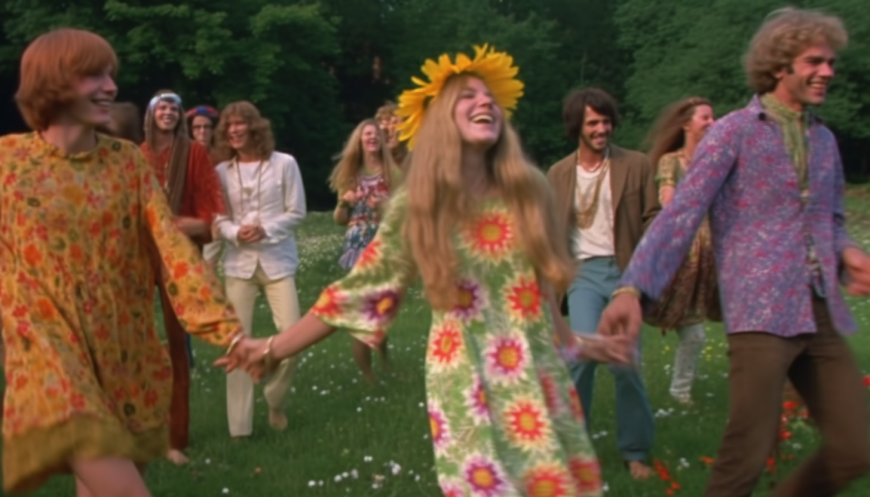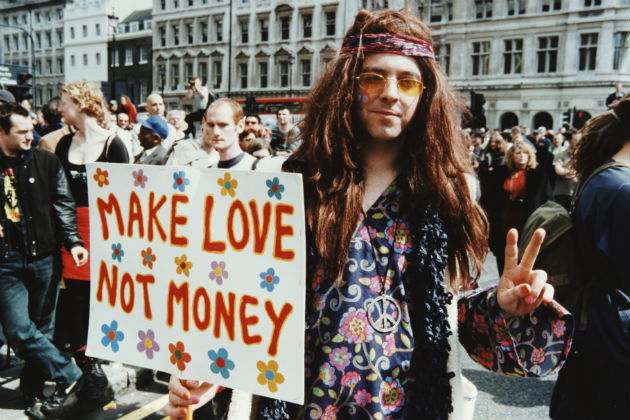Have you ever stopped to think about the clothes people wore in the past, and what those outfits really meant? Like, it's almost as if fashion isn't just about covering up; it’s a way of speaking without saying a single word. So, when we talk about hippie 70s mens fashion, we’re not just looking at bell-bottoms and tie-dye shirts. We’re actually looking at a whole philosophy, a way of life that truly shook things up. This distinct style, very much a part of the countercultural movement, was a bold statement. It was a clear rejection of the usual, everyday American life that many felt was too rigid or just plain wrong.
The hippie movement, you know, it truly started gaining steam on college campuses. It was a time when young people, frustrated with things like the Vietnam War and old-fashioned values, really wanted to express themselves differently. This cultural wave, which began in the early 1960s, grew into something huge, becoming a major international collective. It wasn't just a fleeting trend; it was a deeply influential force. The way men dressed during this period was a direct reflection of these powerful ideas, like peace, freedom, and a new kind of awareness about the world around them. It was, in a way, a visual rebellion.
So, if you're curious about how men embraced this unique look in the 1970s, or perhaps you're thinking about adding a touch of that free-spirited vibe to your own closet, you've come to the right place. We'll explore the specific elements that made up this iconic style, and what each piece really said about the person wearing it. It’s a fascinating journey into a time when clothes were, you know, a very powerful form of protest and self-expression. We'll also consider how these styles continue to pop up in fashion today, showing just how much impact they had.
Table of Contents
- The Roots of Hippie Style: More Than Just Clothes
- Signature Pieces of Hippie 70s Mens Fashion
- Accessories That Spoke Volumes
- The DIY Spirit and Eco-Consciousness
- The Enduring Influence of Hippie 70s Mens Fashion Today
- Frequently Asked Questions About Hippie 70s Mens Fashion
- Wrapping Up the Vibe
The Roots of Hippie Style: More Than Just Clothes
To really get a grip on hippie 70s mens fashion, we first need to understand the movement itself. It was, you know, a countercultural shift that truly rejected the common ways of American life. The whole thing actually started on college campuses, fueled by a deep frustration with the Vietnam War. This political discontent, basically, gave rise to a whole new way of thinking and living. Hippies opposed traditional values, the old foundations of society, and especially wars. Their clothing, therefore, wasn't just random; it was a visible sign of their beliefs.
The movement was all about peace, love, and cosmic consciousness. It embraced things like free love and, you know, a different approach to life that often involved exploring new experiences. The way hippies dressed was, in a way, a rebellion against mainstream society. It celebrated freedom and individuality, which is pretty cool when you think about it. This influential cultural movement, which began in the early 1960s, grew into a very large international collective. So, their style wasn't just a passing fad; it was a deliberate choice to stand apart and express a different vision for the world.
Their fashion was a direct challenge to the neat, structured, and often restrictive clothing that was common at the time. It was about comfort, natural materials, and a certain kind of earthy connection. They weren't interested in looking polished or conforming to corporate standards; they wanted to look authentic, and that's a powerful statement. The whole idea was to be real, to show who you were, and to do it in a way that felt good. This approach, you know, really helped shape the distinct look that became synonymous with the era.
Signature Pieces of Hippie 70s Mens Fashion
When you picture a hippie man from the 70s, certain images probably pop into your head. These weren't just random items; they were chosen for their comfort, their natural feel, and their ability to express a relaxed, anti-establishment attitude. It was, you know, about creating a look that was both laid-back and meaningful. The clothes often had a story, either through their origin or how they were altered. This made each outfit, in a way, quite personal.
Flowing Tops and Tunics
Shirts for hippie men in the 70s were very different from the stiff, collared shirts of earlier decades. You'd often see loose, flowing tops made from natural fabrics like cotton or linen. These might be, you know, peasant shirts with wide sleeves, or perhaps simple tunics that felt airy and comfortable. Patterns were a big deal, too. Tie-dye, of course, was incredibly popular, with its vibrant, swirling colors that seemed to represent a psychedelic journey. Paisley prints, floral designs, and even ethnic patterns from around the world were also very common. These choices, in some respects, showed an openness to different cultures and a love for bright, expressive art.
Beyond the bright colors, you also had a lot of earthy tones. Think about shirts in shades of brown, green, or muted orange. These colors, you know, felt connected to nature, which was a big part of the hippie ethos. Sometimes, shirts would feature embroidery, especially around the neckline or cuffs, adding a handcrafted, personal touch. It was all about rejecting mass-produced uniformity and embracing something unique. A man might wear a shirt that looked like it had been, well, picked up during a trip or perhaps even made by hand, which was a very authentic statement.
Bell-Bottoms and Flared Trousers
When it came to pants, the absolute defining characteristic was the flare. Bell-bottoms were, like, everywhere. These trousers started out fitted at the hip and thigh, then widened dramatically from the knee down. Denim bell-bottoms were incredibly popular, often distressed, faded, or even patched with different fabrics or embroidered designs. It wasn't uncommon to see, you know, a pair of jeans with patches sewn on them, perhaps a peace sign or a flower. This kind of customization really spoke to the DIY spirit of the movement.
But it wasn't just denim. Corduroy bell-bottoms were also a common sight, offering a different texture and often coming in rich, earthy colors. Sometimes, men would wear trousers made from lighter fabrics, also with a flare, especially in warmer climates. The wider leg allowed for more movement and, in a way, symbolized a breaking free from tight constraints. It was a comfortable, relaxed fit that truly embodied the casual, free-spirited vibe of the time. You know, they weren't about sharp creases or stiff lines; they were about flow and ease.
Unique Outerwear Choices
For colder weather or just for adding layers, hippie men had a few go-to options. Ponchos were incredibly popular, often made from wool or woven fabrics with tribal or geometric patterns. They were easy to throw on and, in a way, added a touch of bohemian flair. Denim jackets, often adorned with patches, pins, or hand-painted designs, were also a staple. These jackets were, you know, a canvas for personal expression, telling a story about the wearer's beliefs and experiences.
Leather jackets, particularly those with fringe details, also fit the bill, especially for those with a more rock-and-roll edge. Military surplus jackets, like old army fatigues, were surprisingly common. This was, you know, a powerful ironic statement, taking something associated with war and repurposing it for peace. It was a way of subverting the original meaning and turning it into something new. These jackets were often worn loose and comfortable, sometimes with patches or embroidery that further transformed their original purpose.
Footwear: Comfort and Earthiness
Footwear was often about comfort and practicality, rather than formal style. Sandals, especially leather ones, were a favorite choice, particularly in warmer areas. Many hippies, you know, preferred to go barefoot whenever possible, embracing a connection to the earth. For those times when shoes were needed, simple canvas sneakers, work boots, or even cowboy boots were common. The idea was to choose shoes that felt natural and allowed for easy movement. It was, in a way, a rejection of restrictive or uncomfortable footwear, favoring ease above all else.
Sometimes, you might see handmade moccasins, which further emphasized the connection to indigenous cultures and a more natural way of living. The shoes, like the clothes, weren't about making a grand fashion statement in the traditional sense; they were about feeling good and reflecting a laid-back attitude. It was, you know, a very practical approach to what to put on your feet, but it still had a distinct look.
Accessories That Spoke Volumes
Accessories were, you know, truly essential for completing the hippie look. They weren't just add-ons; they were often symbols of peace, love, and spiritual beliefs. Headbands were incredibly common, worn across the forehead, often made of fabric, leather, or even braided natural materials. They kept long hair out of the way and, in a way, added a distinctive touch. Bandanas, too, were popular, tied around the neck or head.
Beads were a huge part of the accessory game. Long strands of beads, often made of wood, shells, or natural stones, were worn around the neck. Peace signs, of course, were everywhere – on necklaces, pins, or embroidered onto clothing. This symbol, you know, was a clear statement of their anti-war stance. Round, wire-rimmed glasses, often called "John Lennon glasses," were also a common sight, giving a certain intellectual or artistic vibe. Belts were often wide and made of leather, sometimes with large, decorative buckles. Bags were typically simple, like canvas messenger bags or woven shoulder bags, chosen for their utility and natural feel.
Hair and Grooming: A Natural Approach
Perhaps one of the most recognizable aspects of hippie 70s mens fashion wasn't clothing at all, but hair. Long, natural hair was, you know, a very powerful symbol of rebellion against conventional norms. It was a direct contrast to the short, neat haircuts that were common in mainstream society. Men often wore their hair long and untamed, sometimes braided or adorned with beads or flowers. Facial hair, too, was embraced, with beards and mustaches becoming very common. This natural approach to grooming was, in a way, a rejection of artificiality and a celebration of natural beauty. It was about letting things be, you know, just as they were meant to be, without too much fuss or effort.
The idea was to embrace a more natural state, to move away from the highly styled looks that were, you know, seen as part of the "establishment." It was a statement of freedom, a way to say, "I am who I am, and I don't need to conform to your standards." This look, in some respects, was as much a part of the fashion as any piece of clothing. It truly completed the overall vibe of individuality and peace.
The DIY Spirit and Eco-Consciousness
A really important aspect of hippie fashion was the strong emphasis on DIY, or "Do It Yourself." This wasn't just about saving money; it was a core part of their philosophy. They rejected mass consumerism and, in a way, celebrated creativity and self-sufficiency. Clothes were often repurposed, patched, or customized. You'd see old military jackets transformed with embroidery, or jeans adorned with unique patches. This approach, you know, made each piece of clothing truly personal and one-of-a-kind. It was about creating something new from what was already there, which is a pretty cool idea.
There was also a growing awareness of environmental issues. The 1960s counterculture, as my text says, truly embraced ideals like peace, freedom, and environmental awareness. This meant a preference for natural fabrics over synthetics, and a general appreciation for things that were handmade or sourced ethically. It was, you know, a conscious choice to live more simply and to be kind to the planet. This eco-consciousness, in some respects, is something that still resonates with many people today. It was, basically, about living in harmony with nature, and their clothes often reflected that desire.
The Enduring Influence of Hippie 70s Mens Fashion Today
It's pretty amazing how much the hippie 70s mens fashion still pops up in today's world. While you might not see everyone walking around in full bell-bottoms and tie-dye, elements of this style consistently reappear in fashion trends. Think about the popularity of distressed denim, or the return of flared pants. Bohemian styles, with their loose fits and natural fabrics, are also very much influenced by this era. It’s almost as if the spirit of comfort and individuality, you know, just keeps finding new ways to express itself. Designers often draw inspiration from the relaxed, free-spirited vibe of the 70s, bringing it into modern collections.
You can also see the influence in festival fashion, where people often embrace a more eclectic, vintage-inspired look. The idea of personalizing your clothes, adding patches, or making things yourself, is still very much alive. This enduring appeal, in a way, speaks to the timeless desire for self-expression and a connection to something authentic. The core message of peace, freedom, and individuality, which the hippie movement truly championed, continues to resonate. It's not just about clothes; it's about the values they represent, which, you know, are still very relevant in our society today. For more historical context on the movement itself, you might check out a general history resource like Britannica's entry on the Hippie movement.
Frequently Asked Questions About Hippie 70s Mens Fashion
What did hippie men typically wear in the 1970s?
Hippie men in the 1970s typically wore loose-fitting, comfortable clothing. This often included bell-bottom jeans or corduroys, flowing peasant shirts or tunics, and sometimes military surplus jackets. Accessories like headbands, long beaded necklaces, and peace signs were also very common. They often favored natural fabrics and, you know, a very relaxed, unkempt look that was a clear departure from traditional styles.
Why did hippie fashion become so popular?
Hippie fashion became popular because it was a visual representation of a powerful countercultural movement. It rejected mainstream society's norms, including its fashion. The style symbolized peace, freedom, and individuality, appealing to young people who were frustrated with the Vietnam War and traditional values. It was, you know, a way to express dissent and embrace a more authentic, natural way of living.
Can I still find authentic 70s hippie men's clothing today?
Yes, you can still find authentic 70s hippie men's clothing today, though it might take some searching. Vintage shops, online marketplaces specializing in retro clothing, and thrift stores are good places to look. You might also find reproductions or modern pieces inspired by the era. It's, you know, a bit of a treasure hunt, but the unique finds are definitely worth the effort.
Wrapping Up the Vibe
The hippie 70s mens fashion was so much more than just clothes; it was a powerful statement, a visual language for a movement that truly challenged the status quo. From the flowing fabrics and bell-bottoms to the long hair and peace signs, every element spoke of a desire for freedom, peace, and a connection to something more authentic. It was, you know, a rejection of the ordinary and an embrace of individuality. This style, deeply rooted in the counterculture's ideals, still holds a certain charm and relevance even today. So, next time you see a hint of that 70s free spirit in fashion, you'll know the rich history and deep meaning behind it.



Detail Author:
- Name : Mr. Scottie Legros
- Username : wmarvin
- Email : casper.brain@hotmail.com
- Birthdate : 1996-04-03
- Address : 354 Justine Inlet Suite 255 Clintonberg, WV 85846
- Phone : +1-724-304-0622
- Company : Hintz, Moore and O'Keefe
- Job : Biologist
- Bio : Saepe provident magni et fugit iusto et similique perspiciatis. Aperiam sit dolorum saepe ducimus. Nesciunt perspiciatis consequatur aperiam explicabo sed.
Socials
facebook:
- url : https://facebook.com/enoch_official
- username : enoch_official
- bio : Ea accusantium ut quia enim modi ipsa sint. Autem omnis ea at.
- followers : 5559
- following : 1350
linkedin:
- url : https://linkedin.com/in/enochhane
- username : enochhane
- bio : Sequi qui odit in nesciunt.
- followers : 1151
- following : 1946
tiktok:
- url : https://tiktok.com/@enoch.hane
- username : enoch.hane
- bio : Inventore repudiandae quis quia voluptatem deleniti.
- followers : 1522
- following : 44
twitter:
- url : https://twitter.com/hanee
- username : hanee
- bio : Voluptatem est placeat quod dolores qui. Et repellendus voluptas eius ex assumenda excepturi. Sunt repellat sit rerum.
- followers : 1949
- following : 780

